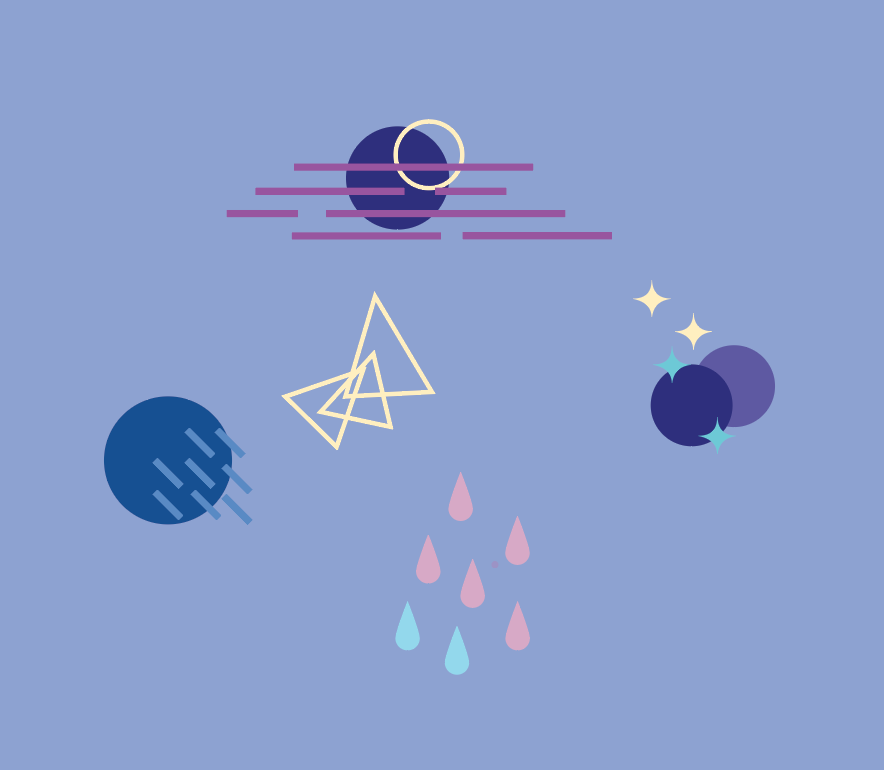// Bettina Chou
// yuchienc@andrew.cmu.edu
// Section C
// Project 5 Wallpaper
function setup() {
createCanvas(480,480);
background("#8ca1d2");
for (var y=0;y<7;y++) {
if (y%2===0) { //every odd row
for (var x = 0; x < 5; x++) {
var ty=y;
var tx=x;
drawTriangles(tx,ty);
drawTrianglesTwo(tx,ty);
HorizontalLines(tx,ty);
TearDrops(tx,ty);
}
}
else {
for (var x = 0; x < 4; x++) { //every even row
var tx=x+.5; //shifts every other row to the right
var ty=y;
drawTriangles(tx,ty);
drawTrianglesTwo(tx,ty);
HorizontalLines(tx,ty);
TearDropsTwo(tx,ty);
}
}
}
noLoop();
}
function TearDrops(tx,ty) {
var TearCounter=random(3); //only draws about a little under half of the tears
if (TearCounter>1.75) {
fill("#728fc9");
noStroke();
push();
translate((tx*100)+50,(ty*50)+random(50));
beginShape();
curveVertex(50,80);
curveVertex(50,80);
curveVertex(58,102);
curveVertex(50,110);
curveVertex(42, 102);
curveVertex(50,80);
curveVertex(50,80);
endShape();
pop();
}
}
function TearDropsTwo(tx,ty) {
var TearCounter=random(3);//only draws about half of the tears
if (TearCounter>1.5) {
fill("#728fc9");
noStroke();
push();
translate((tx*100)-random(10,50),(ty*50)+random(70));
beginShape();
curveVertex(50,80);
curveVertex(50,80);
curveVertex(58,102);
curveVertex(50,110);
curveVertex(42, 102);
curveVertex(50,80);
curveVertex(50,80);
endShape();
pop();
}
}
function drawTriangles(tx,ty) {
noFill();
stroke("#ffefbd");
strokeWeight(2);
push();
translate(tx*95,ty*65);
triangle(50, 25, 65, 47, 35, 47);
pop();
}
function drawTrianglesTwo(tx,ty) {
noFill();
stroke("#ffefbd");
strokeWeight(2);
push();
translate(tx*95,(ty*65)+10); //draws the second in the pair that's translated in the y-direction
triangle(50, 25, 65, 47, 35, 47);
pop();
}
function HorizontalLines(tx,ty) {
noFill();
stroke("#194e93");
strokeWeight(3);
var lineCounter=random(3); //only draws about less than half of line groups
if (lineCounter>1.85) {
push();
translate((tx*80)-20,(ty*60)-random(10,20));
line(65,70,110,70);
line(50,80,80,80);
line(95,80,120,80);
line(85,90,105,90);
pop();
}
}I was inspired by the chilly fall evenings to create a pattern that symbolized the weather. I first sketched a variety of geometric and organic shapes in illustrator and developed a color palette. I simplified the shapes to create more abstract representations of rain, stars, and clouds. Wanting to create something aligning with the characteristics of code (as opposed to trying to “pixel-push”) I realized that mathematical patterns are a key speciality of code. I was inspired by the assignments to create a pseudo-hexagonal grid for all of my elements, and added random omissions and translation variations using conditionals. (try refreshing, the pattern will vary each time!)


![[OLD FALL 2017] 15-104 • Introduction to Computing for Creative Practice](wp-content/uploads/2020/08/stop-banner.png)